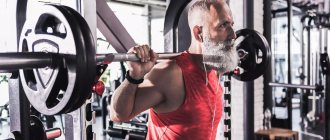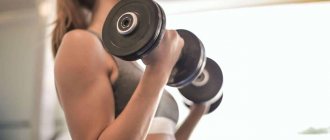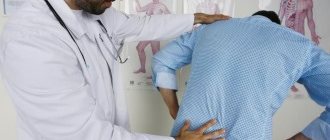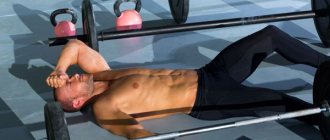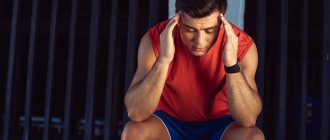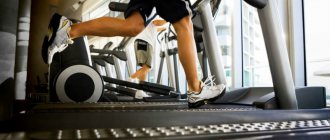Types of muscle pain
- Moderate muscle pain.
Occurs immediately after classes. Its appearance is explained by microtraumas and excess lactic acid in the muscles. This muscle pain is quite mild. - Delayed muscle pain
. Muscles begin to ache a few days after exercise, most often on the second day. This severe muscle pain prevents the muscle from contracting fully. It usually occurs with very intense training in beginners without a period of adaptation to the load, as well as with too much emphasis on eccentric loads (muscle stretching when lowering weights). - Muscle pain from injury.
First sharp, then aching, constraining, aggravated by the slightest load or sudden movement. In addition, it may be accompanied by swelling and hyperemia of the damaged area. Regardless of the nature of the injury, in such cases it is necessary to consult a doctor. The most serious injuries characterized by this type of pain are muscle rupture, nerve compression, joint damage, etc.
Method of obtaining energy
Muscles can replenish energy reserves in various ways. For example, both with the use of oxygen (aerobic pathway) and without it (anaerobic pathway), when our “energy tanks” (glycogen reserves) are converted into ATP (adenosine triphosphate), which is very important for us.
This is what promotes the release of lactic acid, which is almost immediately removed from the muscles by the blood. But during training, our muscles work like a pump (blood gets in, but getting out is difficult), so lactic acid stays in the trained muscle for quite a long time, causing a characteristic burning sensation that is so familiar to us!
Lactic acid is made up of lactate anion and hydrogen, which causes a burning sensation by lowering the pH level. However, this is a fairly quick process, and after training, the pH level stabilizes almost immediately, and the burning sensation disappears.
The more blood we pump into the muscle, the stronger the burning sensation. But how to grow without constantly feeling a burning sensation?
How to get rid of muscle pain?
Muscle pain from training, including in the legs, is a transient phenomenon. And it’s easy to deal with by following a few rules.
- Balanced diet.
The body of a person engaged in training must necessarily receive proteins, carbohydrates and fats. The calorie content of dishes directly depends on the metabolic rate, health status and training goals. If there is a lack of nutrients, the body will not be able to fully recover after exercise. - Drinking regime.
Getting enough water into the body helps eliminate toxins that negatively affect muscle recovery after intense physical activity. - Contrast shower and cold compresses.
They help eliminate muscle pain and fatigue. It is worth considering that a contrast shower involves alternating cool and warm water, rather than hot and ice. - Massage.
Helps improve blood circulation, resulting in more oxygen and nutrients entering the tissues, and at the same time, toxins are more actively eliminated. - A complete night's rest.
Eight hours of sleep is an essential part of every athlete’s daily routine. Otherwise, the body will have an increased level of cortisol, which will negatively affect the recovery of the body and the intensity of muscle pain, which will only increase. - Competent approach to classes
. It includes a thorough warm-up, proper execution of all exercises, and a balanced training regimen. Rehabilitation exercises after the onset of pain include exercise on an exercise bike and long-distance running.
Up to contents
Exercises after abdominoplasty
Leading an active sports life, the restrictions after abdominoplasty seem excessive to many. However, you need to be clearly aware that starting training earlier than prescribed by your doctor can cause serious complications. The progressive movement from simple to complex will ensure systematic strengthening of tissues, eliminating the need to do a repeat abdominoplasty if the seams come apart. You should start sports training only under the supervision of an experienced trainer who clearly understands exactly what processes occur in the body after tummy tuck. For any changes in condition, you should immediately consult with the surgeon who performed the abdominoplasty. Sudden loads leading to excessive tension of the skin can provoke tissue rupture, the development of necrosis, the appearance of new edema, and hematomas.
On a note!
Strict adherence to the instructions of the attending physician and constant wearing of the bandage during the first months of rehabilitation will speed up the recovery process and reduce the risk of developing atypical scars.
Bandage is an important element of postoperative body recovery
Immediately after the surgeon completes the work after a classic abdominoplasty, the patient is put on a bandage before he recovers from anesthesia. A tight belt fixes the muscles and provides complete protection against overexertion during movement, bending or turning. After a week, instead of a belt, you can wear special high-waisted panties or a bodysuit.
Compression underwear is made of hygroscopic, anti-allergenic material that provides free access of air and quickly absorbs sweat. The structure of the fabric of the bandage guarantees regular soft massage when walking, which accelerates the disappearance of swelling and bruises. The bandage can be removed only after the scarring of the surgical incision has completely completed and the permission of the attending physician has been obtained.
Return to active training after abdominoplasty
A tummy tuck does not allow you to immediately return to your usual lifestyle, despite excellent physical fitness. The skin, muscles, and subcutaneous tissue are severely injured; recovery will take at least 2 months. At first, even for rest, a special pillow is used, placed under the knees, to minimize the tension of the skin at the site of the incisions. You can get up or lie down only with the support of medical staff or relatives.
Restoring physical activity in the first two weeks
Complete healing of the suture will require at least two months. The first knocks after tummy tuck are the hardest. Pain, bruising, and swelling cause not only physical inconvenience, but also significant emotional problems. The appearance after abdominoplasty is very unpresentable. To prepare in advance for how your body will look, immediately after emerging from anesthesia, look at the before and after photos of classic abdominoplasty in your portfolio. This will prepare you for reality and help you avoid serious stress.
The first week should mobilize all internal reserves, since you will have to actively fight the negative consequences of surgery. No matter how difficult it is to get up, you need to gradually increase the time you spend on your feet on the second or third day, moving 30-40 meters around the ward. The first serious sports victory during this period was independent, slow movement at a distance of up to 100 meters. You should not fall into euphoria from success and neglect the help of staff or relatives. If you experience any negative sensations in the area of scarring sutures, immediately consult a plastic surgeon.
Two weeks after the recovery period has begun, if there are no complications and proper progress towards recovery, the doctor will give permission to increase the load. If before tummy tuck the patient was actively involved in sports, the muscle corset was in ideal condition, you can move forward. Walking is permitted for up to one kilometer in the park, with benches for rest along the entire route chosen for walking. You need to carefully monitor the state of your body, do not overexert yourself, and immediately stop moving if any discomfort or pain occurs.
Four weeks have passed since abdominoplasty
After a month, the doctor will allow trained athletes to begin more active training.
- Walking can alternate between acceleration and mandatory periods of rest.
- The trainer, after consultation with the attending physician, will give permission to exercise on an exercise bike or do a lying bicycle exercise.
- If the abdominal muscles were not affected during abdominoplasty, you can increase the load by using dumbbells weighing up to 3 kg for exercises.
- If there are no complications, you can start exercising on an elliptical, treadmill or exercise bike.
Important!
Do not forget that each person’s body has its own reserves of strength. If life was passive before plastic surgery, early training is dangerous to health, since the skin and muscle tissue are not adapted to additional stress.
Control line in the rehabilitation period is 3-4 months
This is the time when the doctor sees how successful the plastic surgery was, how the tissue is scarring, and how the body is recovering after a complex operation. After the examination, you can touch on the topic of the exact timing of the start of active training to restore your previous form. After two to three months, the plastic surgeon gives permission to begin aerobic training. You can start doing cardio exercises or jogging short distances. At this time, exercise in the pool, yoga, Pilates, and fitness are encouraged.
After four months, training to strengthen the abdominal muscle corset becomes available. You can use loads weighing up to three kilograms. Training should take place under the constant supervision of an experienced specialist who is familiar with the fact that the athlete has recently undergone tummy tuck. With the most minor negative changes in the condition, you should immediately consult with the surgeon who performed the operation. Do not forget that for up to 2 months the bandage must protect the incision site from additional forces.
Six months after tummy tuck
Patients are allowed to fully engage in sports, excluding team games, where there is a high probability of strong blows to the body. Training is carried out under the constant supervision of a trainer who is able to instantly respond to any changes in the athlete’s condition. The individual training program must be agreed upon with the attending physician. An athlete, no matter how prepared he was before plastic surgery, must realize that he has to start all over again.
- Sports loads when using exercise machines begin with the smallest indicators. By increasing the weight of the load, the number of approaches is reduced.
- While pumping your abs, carefully monitor your well-being. If discomfort or pain appears, the training is stopped immediately. If your condition does not improve after rest, consult your doctor immediately.
- There is a direct dependence on the speed of recovery of the body on the chosen abdominoplasty technique. After minimally invasive surgeries, rehabilitation takes less time.
Don't rely on other tummy tuck patients. Each person's body responds individually to such operations. Much depends on the initial state of the body, professional sports training, and other factors. Only the attending physician can determine how effectively tissue regeneration processes are proceeding and when you can begin the active phase of training.
Who is more likely to experience swelling after exercise?
Women are most susceptible to them. What factors influence this?
* premenstrual syndrome. “Before menstruation, the hormonal balance is disrupted - the relative content of estrogens increases, and estrogens retain fluid in the body,” notes Yesenia Kalyuzhnaya.
* pregnancy. During pregnancy, a woman's body produces a large amount of progesterone, which reduces vascular tone. “This promotes blood stagnation in the lower extremities. The growing fetus can compress large vessels, which also causes swelling. They can also be a manifestation of gestosis (late toxicosis of pregnant women),” says Yesenia Kalyuzhnaya.
* wearing shoes with heels;
* presence of excess weight or, conversely, underweight;
* presence of problems with blood vessels.
If swelling occurs regularly after training (and without it), it makes sense to consult a doctor.
Reasons for the absence of pain
- Monotony of exercises and automaticity. Performing the same loads on the same muscle group, for example, the abdominal muscles, can lead to the disappearance of pain. This is due to the body’s adaptation and the cessation of muscle fiber ruptures. Some may advise you (even some super-mega experts) that “ideally, you should do no more than four identical workouts if you want to achieve a positive result.” But still, do not forget that it makes sense to change the training scheme only after it has outlived its usefulness. I already talked about this above.
- Your strength and endurance have increased. This means that you should increase the intensity of training and working weights. You can also try a new sport or develop a new exercise program.
- You are "philoning". If you are not working at the limit of your capabilities, then your efficiency decreases and may even be zero. Therefore, reconsider your attitude towards training. If you lack motivation, you need to increase it. There is an awesome article about this on the topic of motivation.
- Reduced sensitivity threshold. Receptors responsible for sensitivity and sensations of pain stop sending signals to the brain.
- Fast muscle regeneration. This is not a reason to panic. We can simply congratulate you on this.
I get swollen after a workout: when is it time to see a doctor?
How long does it take for swelling to go away? Normally, a day or two after appearance. “If swelling does not subside for more than 3-4 days and pain appears, it is recommended to consult a doctor,” notes Ruslan Panov.
There is no point in delaying a visit to the doctor, experts say. “Any swelling that is visually quite pronounced requires consultation with a doctor. They are often the body’s first signals about serious abnormalities associated with metabolic processes, says Yesenia Kalyuzhnaya. “It is especially dangerous if swelling forms on the face and neck, spreads to the eyes, fingers, and on the legs; swelling interferes with wearing shoes and moving, if swelling occurs regularly or persists constantly, or pain occurs.”
Causes of muscle swelling
Muscles can swell in both beginners and experienced athletes. “Edema is an external, quite noticeable swelling of tissue. Swelling occurs due to excessive accumulation of fluid in organs and extracellular tissue spaces of the body,” says Yesenia Kalyuzhina, a rehabilitation physician at the SportMedica sports medicine clinic.
Why is this happening? “There are several reasons for the occurrence: from overtraining to pathological changes,” says Ruslan Panov, expert methodologist and coordinator of X-Fit group programs in Russia . “Muscle swelling most often appears due to inadequate load, long breaks in the training process, and excessive water consumption.”
If you have “overloaded” your muscles, swelling can manifest itself in two ways. “The first is that a large amount of work and vital activity products of fiber and cells accumulate in muscle tissue, and the lymph flow cannot cope with their removal, the cell swells, and the lymphatic fluid stagnates,” explains Ruslan Panov.
The second way is the appearance of micro-tears in the muscle fiber during strength training. “The process of gaining muscle mass is directly related to microtraumas, in which fibers tear and grow together and increase in volume, which leads to inflammation and swelling, despite the fact that this is natural,” adds Ruslan Panov.
What is happening in the muscle at this moment? “Due to structural damage, an inflammatory response develops in the muscle. First, the blood vessels constrict to prevent blood loss, and then the opposite effect occurs with the goal of using chemical signals to attract immune cells from the blood vessels into the damaged muscle tissue, which causes the accumulation of fluid in the tissue,” explains Yesenia Kalyuzhina.
As a rule, intense or unusual exercise leads to muscle swelling. “One of the consequences is “delayed muscle soreness,” which results in swelling. As a rule, after 5-7 days the pain goes away. Untrained people who expose themselves to too much stress often suffer. Or athletes who use unusual types of load for themselves,” adds Yesenia Kalyuzhina.
However, if you are not generally into sports, then swelling after exercise can occur from any load in general. “If the trainee’s body is not accustomed to stress (when a sedentary lifestyle predominates, for example), then any activity can become for him the very critical intensity at which swelling occurs, either due to microtrauma or the accumulation of waste from muscle activity,” - says Ruslan Panov.
In addition, swelling of the extremities can also appear for reasons that have nothing to do with fitness. According to Yesenia Kalyuzhnaya, the reasons for this are also:
- wearing tight shoes or high heels (this interferes with the normal outflow of blood and lymph);
- sitting in an uncomfortable position (crossing your legs, you block the lymph flow);
- fatigue of the lower extremities (especially if you spent the entire day before training on your feet);
- excessive fluid intake;
- excessive consumption of salty and spicy foods;
- hot weather;
- phlebeurysm;
- injuries;
- impaired renal excretory function;
- heart failure;
- hormonal imbalances;
- obesity;
- pregnancy;
- allergy.
What to do during acute respiratory infections
Your task is to help the body as much as possible in the fight against the scourge.
It will help you:
- sleep a lot - regeneration and rest occur during sleep;
- eat light food to get vitamins and energy to fight viruses;
- be treated symptomatically - but do not overdo it with pharmaceutical drugs and traditional medicine, most OZRs are not treated in any way;
- walk, read, relax - spend time outdoors rather than watching TV;
- think about how you will correctly and carefully return to training after illness.
I swell after training: what to do?
Did you experience swelling after exercise? Experts recommend speeding up the process of its resorption. “It is important to pay attention in time to an increase in the volume of a limb or torso and respond correctly by taking restorative measures. Massages often help, and they vary: from restorative and relaxing to hard sports, but warming up in a sauna is not recommended, since the morphology of the process is unclear,” says Ruslan Panov.
No opportunity to visit a massage therapist? Practice myofascial release. “The essence of this effect is self-massage using hard foam rolls (you can replace them with a tightly closed bottle) and tennis balls,” explains Ruslan Panov. — The ball or roll should press the muscle in need of action to the bone. Then, in this position, you need to perform slow longitudinal or transverse rolling, adjusting the intensity by applying body weight.”
Another method to relieve swelling is kinesio taping. “This is the application of special patches with an adhesive layer that stimulate the nervous network to enhance the lymphatic drainage effect. This is the easiest way to remove excess fluid from tissue of any location (muscle swelling can appear anywhere, although large muscle groups are most susceptible: thighs, calves and ankles, back, arms),” says Ruslan Panov. It will also be useful to wear compression garments (gaiters, long sleeves) to stimulate lymph flow.

